Performance Evaluation of Root Zone Heating System Developed with Sustainable Materials for Application in Low Temperatures
Abstract
:1. Introduction
2. Materials and Methods
2.1. Experimental Setup
2.2. Developing the Root Zone Heating System
2.3. Heat Transfer in Porous Medium Module
2.4. Analysis of Time Interval and Boundary Conditions
3. Results and Discussion
4. Discussion
5. Conclusions
Author Contributions
Funding
Conflicts of Interest
References
- Memon, M.S.; Guo, J.; Tagar, A.A.; Perveen, N.; Ji, C.; Memon, S.A.; Memon, N. The Effects of Tillage and Straw Incorporation on Soil Organic Carbon Status, Rice Crop Productivity, and Sustainability in the Rice-Wheat Cropping System of Eastern China. Sustainability 2018, 10, 961. [Google Scholar] [CrossRef]
- Li, X.; Lu, W.; Hu, G.; Wang, X.C.; Zhang, Y.; Sun, G.X.; Fang, Z. Effects of light-emitting diode supplementary lighting on the winter growth of greenhouse plants in the Yangtze River Delta of China. Bot. Stud. 2016, 57. [Google Scholar] [CrossRef] [PubMed]
- Rosenthal, E. Rootzone Temperature. Available online: https://www.cannabisculture.com/content/2002/08/02/2565/ (accessed on 12 April 2018).
- Ingram, D.L.; Basford, B.H.; Foster, W.H.; Ramcharan, C. Electronically controlled root heating tubes. Hortscience 1990, 25, 693–694. [Google Scholar]
- Chris, P. Is Root Zone Heating Really Necessary? Available online: https://www.maximumyield.com/is-root-zone-heating-really-necessary-part-one-the-basics/2/922 (accessed on 14 July 2018).
- Abd El Rahman, A.A.; Kuiper, P.J.C.; Bierhuizen, J.F. Preliminary Observations on the Effect of Soil Temperature on Transpiration and Growth of Young Tomato Plants under Controlled Conditions; Mededelingen Van de Landb Hoogesch: Wageningen, The Netherlands, 1959. [Google Scholar]
- Jenkins, B.M.; Sachs, P.M.; Forister, G.W.; Sisto, I. Thermal Response of Greenhouses under Bench and Perimeter Heating; ASAE Paper 89-4038; ASAE: St. Joseph, MI, USA, 1989. [Google Scholar]
- Christenbury, G.D. Energy Management with Root-Zone Heating; The University of Georgia: Athens, GA, USA, 1990. [Google Scholar]
- Richards, S.J.; Hagan, R.M.; McCalla, T.M. Soil Temperature and Plant Growth. Agronomy 1952, 2, 303–481. [Google Scholar]
- McAvoy, R.J.; Janes, H.W. The effects of root zone heating in conjunction with standard and cool night conditions on the growth of chrysanthemums. In Acta Horticulturae; International Society for Horticultural Science (ISHS): Leuven, Belgium, 1984; pp. 843–852. [Google Scholar]
- Moorby, J.; Graves, C.J. Root and air temperature effects on growth and yield of tomatoes and lettuce. In Acta Horticulturae; International Society for Horticultural Science (ISHS): Leuven, Belgium, 1980; pp. 29–44. [Google Scholar]
- Went, F.W. Plant Growth under Controlled Conditions. II. Thermoperiodicity in Growth and Fruiting of the Tomato. Am. J. Bot. 1944, 31, 135–150. [Google Scholar] [CrossRef]
- Diver, S. Root Zone Heating for Greenhouse Crops. Available online: http://ceac.arizona.edu/sites/default/files/diver_-_root_zone_heating.pdf (accessed on 17 June 2018).
- Falah, M.A.F.; Wajima, T.; Yasutake, D.; Sago, Y.; Kitano, M. Responses of root uptake to high temperature of tomato plants (Lycopersicon esculentum Mill.) in soil-less culture. Int. J. Agric. Technol. 2010, 48, 543–558. [Google Scholar]
- Jaworski, C.A.; Valli, V.J. Tomato Seed Germination and Plant Growth in Relation to Soil Temperatures and Phosphorus Levels. Fla. State Hortic. Soc. 1964, 77, 177–183. [Google Scholar]
- Fujishige, N.; Sugiyama, T. Effect of soil temperature on growth of seedlings of a few fruit vegetables (a preliminary report). J. Jpn. Soc. Hortic. Sci. 1968, 37, 221–226. [Google Scholar] [CrossRef]
- ICIS Propylene. Available online: https://www.icis.com/chemicals/propylene (accessed on 4 August 2017).
- Avci, H.; Özdemir, A. Sustainable Approach to Produce Polyurethane Composite Foams with Natural Materials. Celal Bayar Üniv. Fen Bilim. Derg. 2017, 13, 887–892. [Google Scholar] [CrossRef]
- Van Os, E.A. Closed soilless growing systems: A sustainable solution for Dutch greenhouse horticulture. In Water Science and Technology; Elsevier Science Ltd.: Pergamon, Turkey; Kidlington, UK; Oxford, UK, 1999; Volume 39, pp. 105–112. [Google Scholar]
- National Geographic. Greendex: Consumer Choice and the Environment a Worldwide Tracking Survey Report. Toronto, Canada, 2014; pp. 1–20. Available online: https://globescan.com/wp-content/uploads/2017/07/Greendex_2014_Highlights_Report_NationalGeographic_GlobeScan.pdf (accessed on 3 January 2018).
- Bragg, N. A Review of Peat Reserves and Peat Usage in Horticulture and Alternative Materials; Report; The Horticultural Development Company (HDC): Petersfield, UK, 1990. [Google Scholar]
- Professional Plastics. Thermal Expansion Properties of Plastic Materials. Available online: https://www.professionalplastics.com/professionalplastics/ThermalPropertiesofPlasticMaterials.pdf (accessed on 5 August 2017).
- Co, E.; Kyoto, E. Thermal Insulation Materials Polyurethane (PUR) and Polyisocyanurate (PIR) Foam. Available online: http://www.react-ite.eu/uploads/tx_mddownloadbox/PP02_Thermal_insulation_materials_-_PP02_20130715.pdf (accessed on 28 July 2017).
- Joe Davids Cocopeat Profile Test. Available online: http://www.cocopeat.com.au/technical/productAnalysis/pdf/TechnicalAnalysis2001.pdf (accessed on 12 August 2017).
- Nield, D.A.; Bejan, A. Convection in Porous Media, 4th ed.; John Wiley & Sons Inc.: Hoboken, NJ, USA, 2013; ISBN 9781461455417. [Google Scholar]
- Wakao, N.; Kaguei, S.; Funazkri, T. Effect of fluid dispersion coefficients on particle-to-fluid heat transfer coefficients in packed beds. Correlation of nusselt numbers. Chem. Eng. Sci. 1979, 34, 325–336. [Google Scholar] [CrossRef]
- Bear, J.; Bachmat, Y. Introduction to Modeling of Transport Phenomena in Porous Media, 1st ed.; Springer: Dordrecht, The Netherlands, 1990; ISBN 978-0-7923-1106-5. [Google Scholar]
- Minkowycz, W.J.; Haji-Sheikh, A.; Vafai, K. On departure from local thermal equilibrium in porous media due to a rapidly changing heat source: The Sparrow number. Int. J. Heat Mass Transf. 1999, 42, 3373–3385. [Google Scholar] [CrossRef]
- Amiri, A.; Vafai, K. Transient analysis of incompressible flow through a packed bed. Int. J. Heat Mass Transf. 1998, 41, 4259–4279. [Google Scholar] [CrossRef]
- Carbonell, R.G.; Whitaker, S. Heat and Mass Transfer in Porous Media BT. In Fundamentals of Transport Phenomena in Porous Media; Bear, J., Corapcioglu, M.Y., Eds.; Springer: Dordrecht, The Netherlands, 1984; pp. 121–198. ISBN 978-94-009-6175-3. [Google Scholar]
- Jury, W.A.; Gardner, W.R.; Gardner, W.H. Soil Physics, 5th ed.; John Wiley & Sons Inc.: Hoboken, NJ, USA, 1991. [Google Scholar]
- DeVries, D.A. Thermal Properties of Soils. In Physics of Plant Environment; van Wijk, W.R., Ed.; John Wiley & Sons Inc.: New York, NY, USA, 1963. [Google Scholar]
- Campbell, G.S.; Jungbauer, J.D.; Bidlake, W.R.; Hungerford, R.D. Predicting the effect of temperature on soil thermal conductivity. Soil Sci. 1994, 158, 307–313. [Google Scholar] [CrossRef]
- Bazgaou, A.; Fatnassi, H.; Bouhroud, R.; Gourdo, L.; Ezzaeri, K.; Tiskatine, R.; Demrati, H.; Wifaya, A.; Bekkaoui, A.; Aharoune, A.; et al. An experimental study on the effect of a rock-bed heating system on the microclimate and the crop development under canarian greenhouse. Sol. Energy 2018, 176, 42–50. [Google Scholar] [CrossRef]
- Fabrizio, E. Energy reduction measures in agricultural greenhouses heating: Envelope, systems and solar energy collection. Energy Build. 2012, 53, 57–63. [Google Scholar] [CrossRef]
- Cuce, E.; Harjunowibowo, D.; Mert, P. Renewable and sustainable energy saving strategies for greenhouse systems: A comprehensive review. Renew. Sustain. Energy Rev. 2016, 64, 34–59. [Google Scholar] [CrossRef]
- Soltani, M.; Kashkooli, F.M.; Kazemi, A.R.; Bordbar, N.; Farshchi, M.J.; Elmi, M.; Gharali, K.; Dusseault, M.B. A comprehensive study of geothermal heating and cooling systems. Sustain. Cities Soc. 2018. [Google Scholar] [CrossRef]
- Hassanien, R.H.E.; Li, M.; Tang, Y. The evacuated tube solar collector assisted heat pump for heating greenhouses. Energy Build. 2018, 169, 305–318. [Google Scholar] [CrossRef]
- Xu, J.; Li, Y.; Wang, R.Z.; Liu, W. Performance investigation of a solar heating system with underground seasonal energy storage for greenhouse application. Energy 2014, 67, 63–73. [Google Scholar] [CrossRef]
- Joudi, K.A.; Farhan, A.A. Greenhouse heating by solar air heaters on the roof. Renew. Energy 2014, 72, 406–414. [Google Scholar] [CrossRef]
- Gonzalez-Fuentes, J.A.; Shackel, K.; Heinrich Lieth, J.; Albornoz, F.; Benavides-Mendoza, A.; Evans, R.Y. Diurnal root zone temperature variations affect strawberry water relations, growth, and fruit quality. Sci. Hortic. 2016, 203, 169–177. [Google Scholar] [CrossRef]
- Abdel-Mawgoud, A.M.R.; Sassine, Y.N.; El-Behairy, U.A.; Abou-Hadid, A.F.; El-Abd, S.O. Effect of Minimum Root-zone Temperature on the Growth and Production of Greenhouse Sweet Pepper. J. Appl. Sci. Res. 2005, 1, 72–77. [Google Scholar]
- Sakamoto, M.; Suzuki, T. Effect of Root-Zone Temperature on Growth and Quality of Hydroponically Grown Red Leaf Lettuce (Lactuca sativa L. cv. Red Wave). Am. J. Plant Sci. 2015, 6, 2350–2360. [Google Scholar] [CrossRef]
- Olberg, M.W.; Lopez, R.G. Growth and development of poinsettia (Euphorbia pulcherrima) finished under reduced air temperature and bench-top root-zone heating. Sci. Hortic. 2016, 210, 197–204. [Google Scholar] [CrossRef]
- Tachibana, S. Effect of Root Temperature on the Rate of Water and Nutrient Absorption in Cucumber Cultivars and Figleaf Gourds. Notes Queries 1987, s11-II, 309. [Google Scholar] [CrossRef]
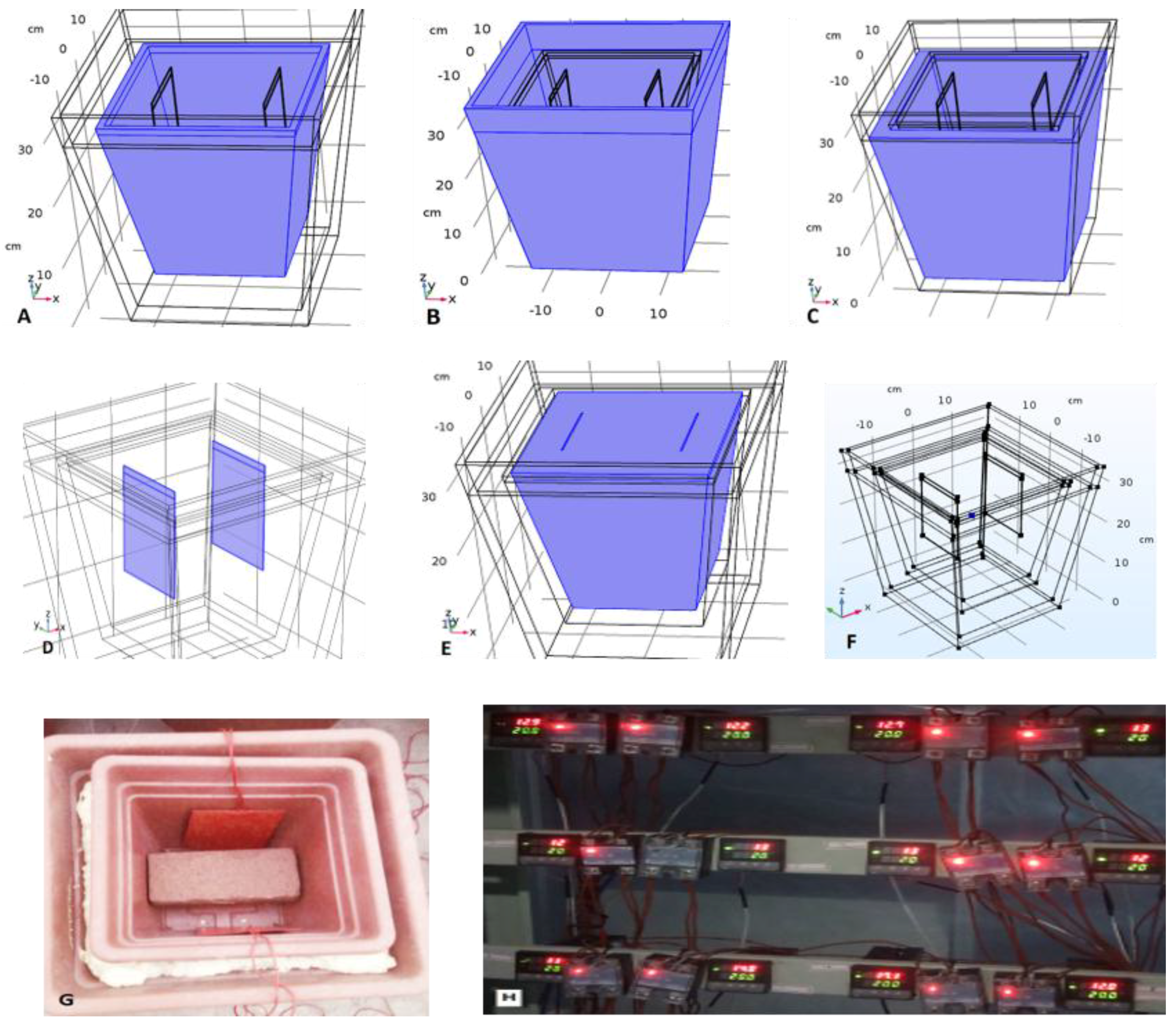
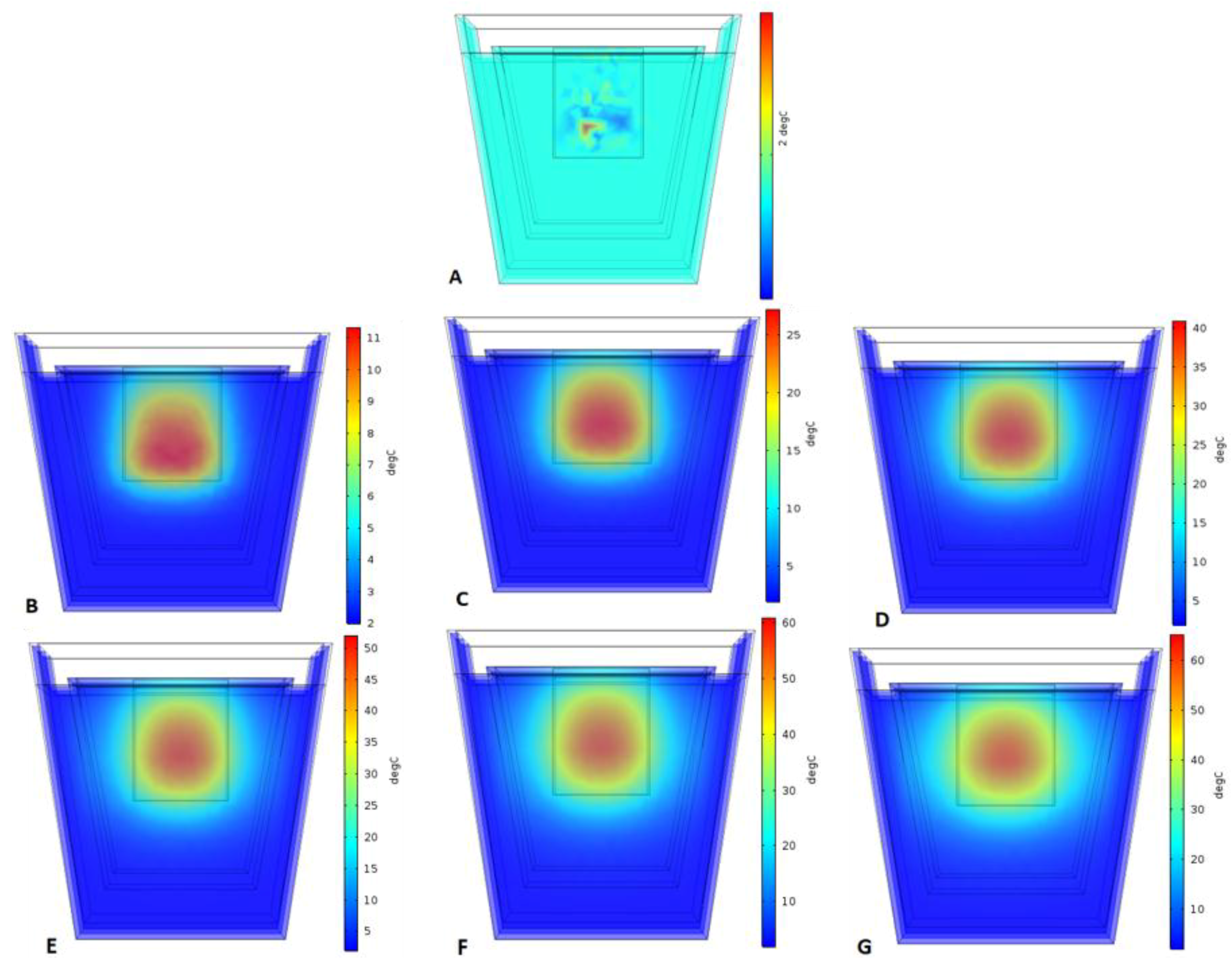
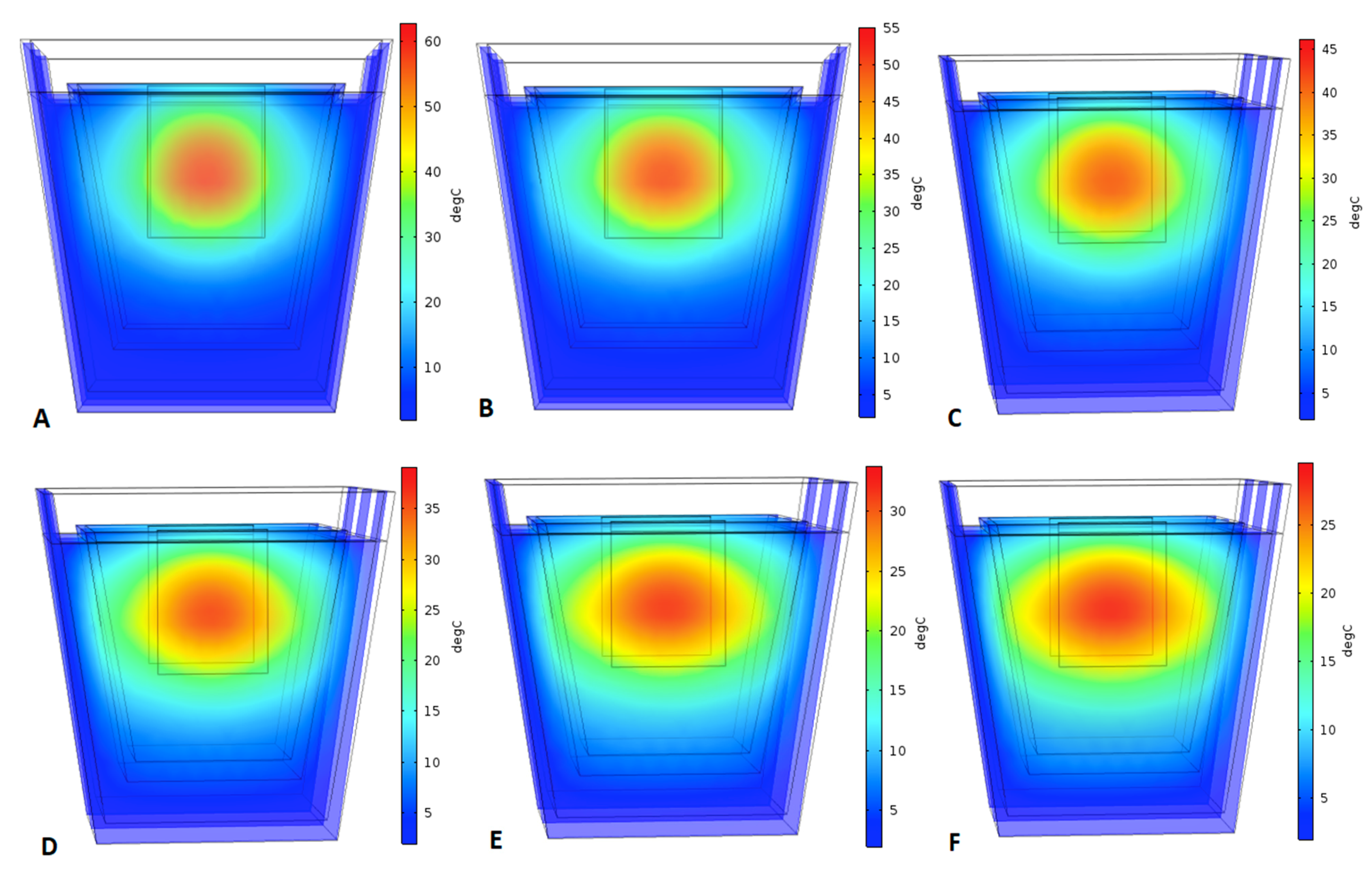
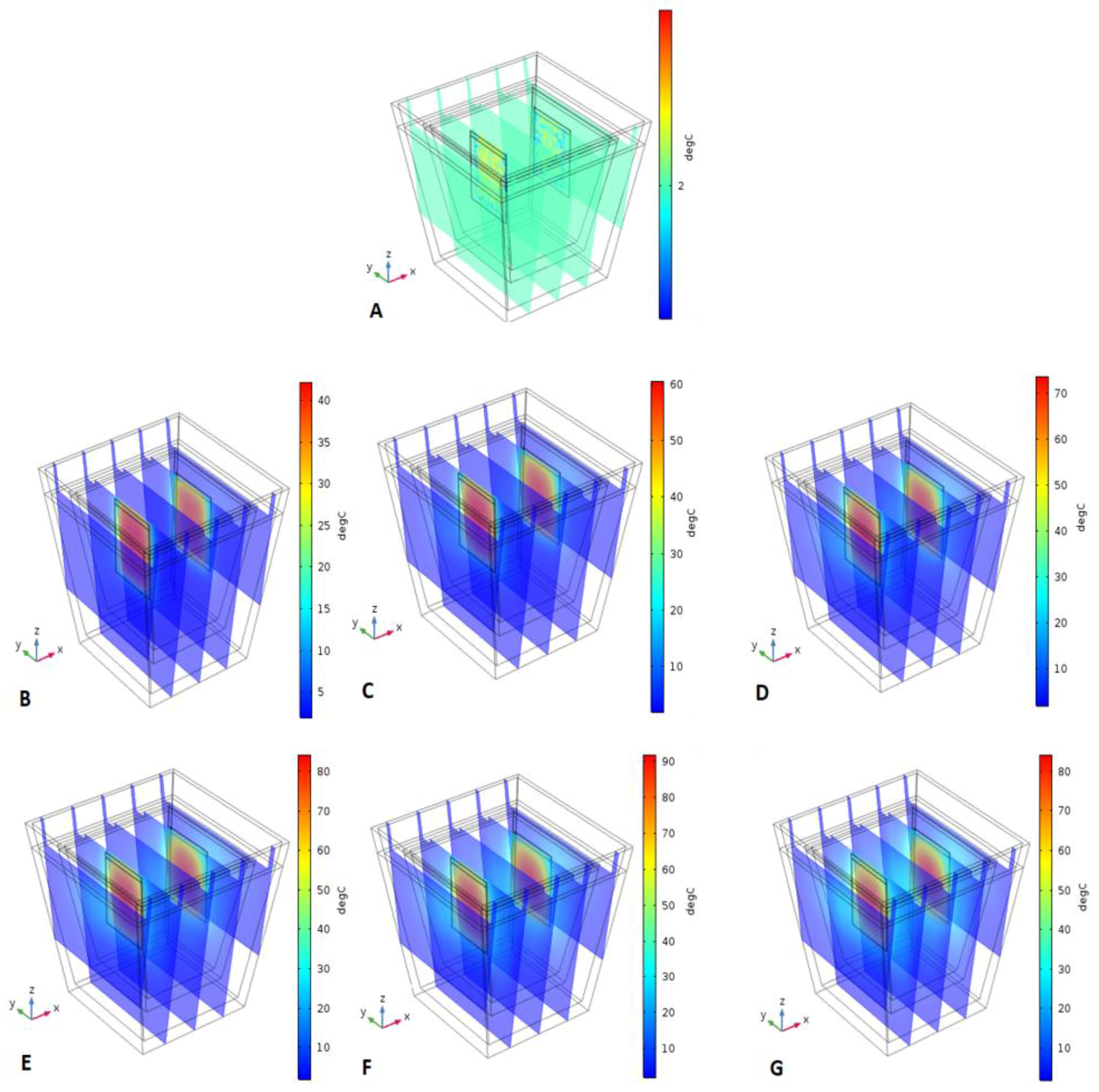
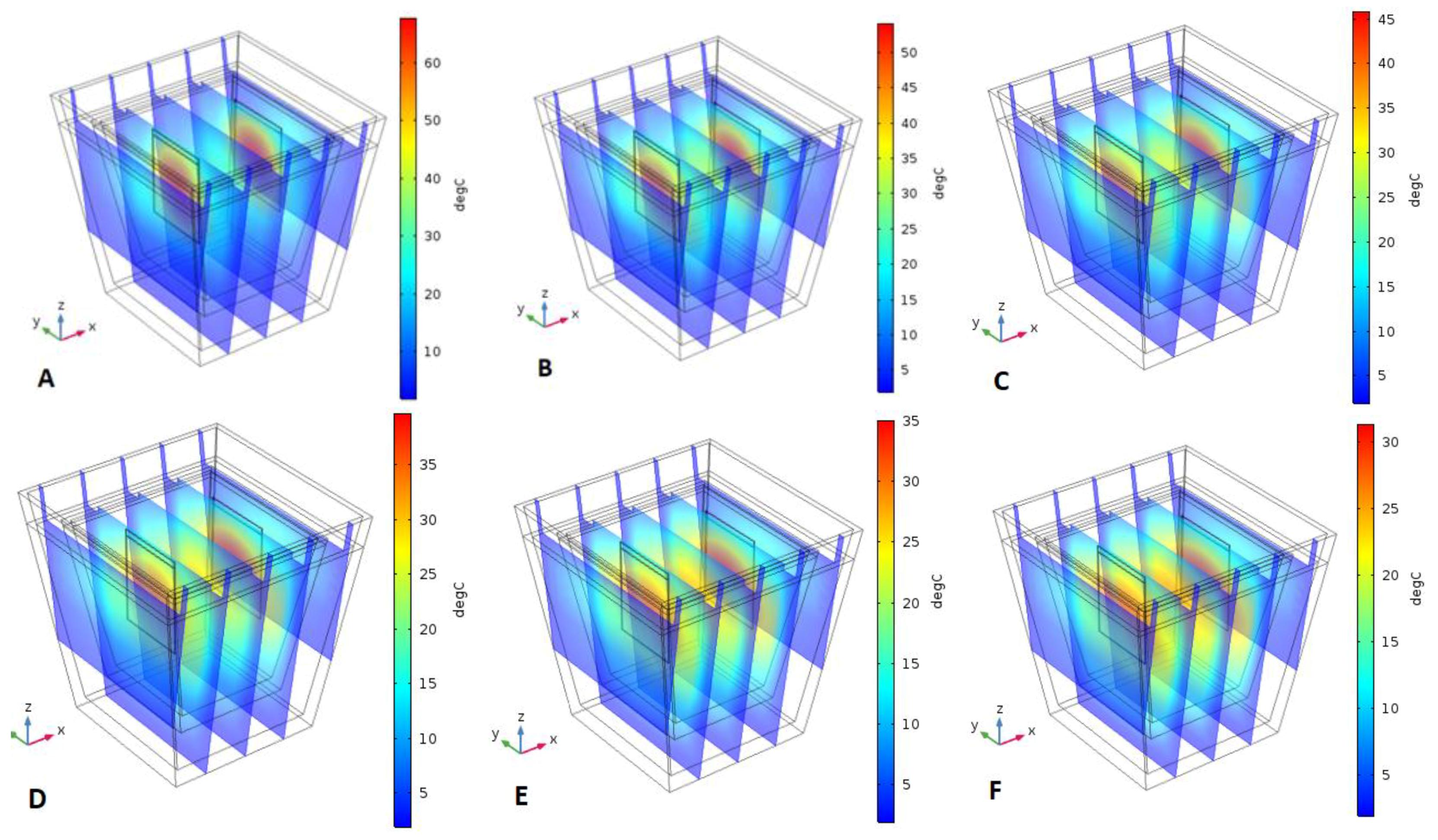
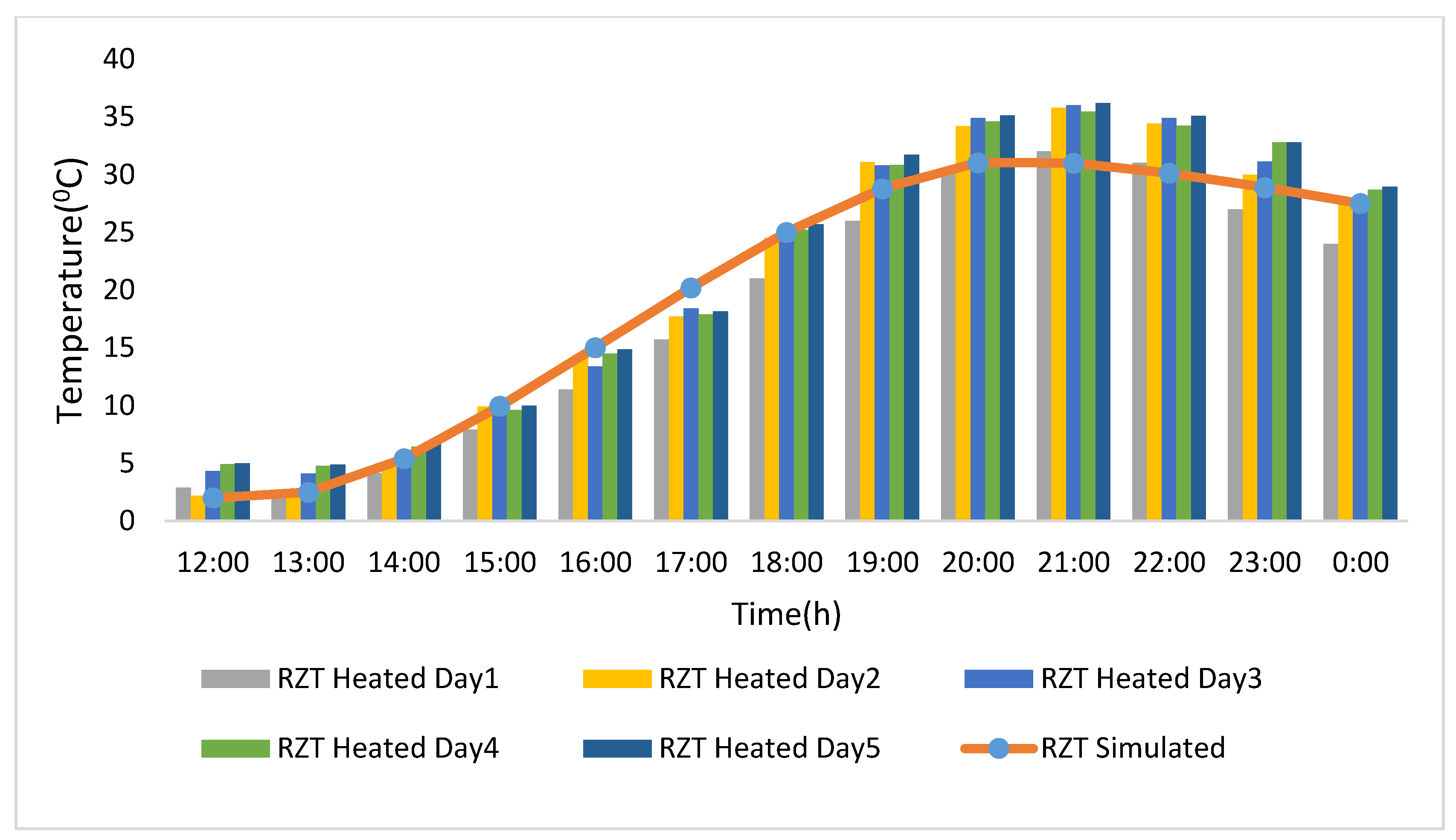
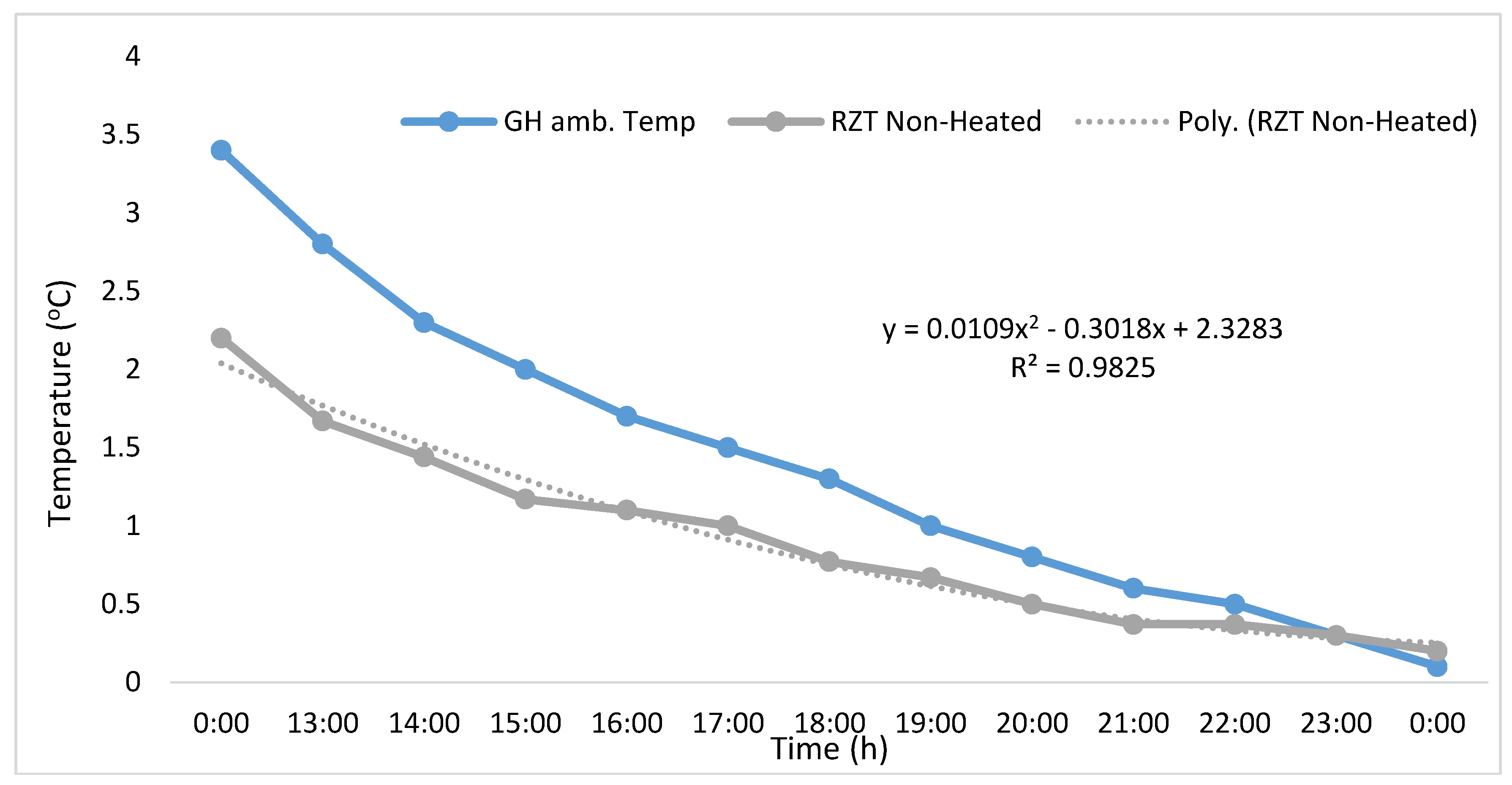
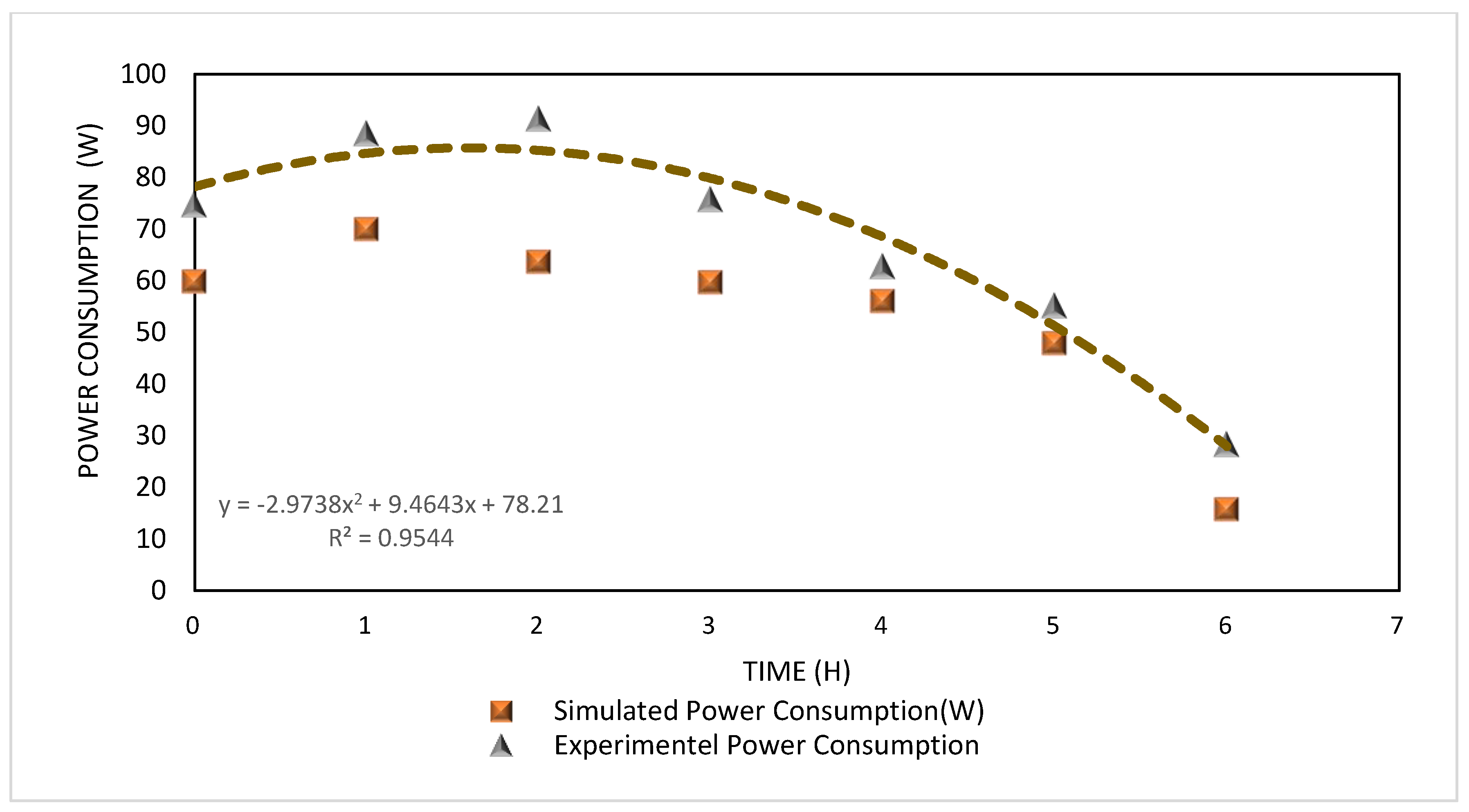
| Sr. No | Type | Unit | Inner Pot | Outer Pot |
|---|---|---|---|---|
| 1 | Lower working temperature | °C | −60 | −60 |
| 2 | Specific heat capacity | J/kg K | 1926 | 1926 |
| 3 | Density | kg/m3 | 946 | 946 |
| 4 | Thermal conductivity | W/m K | 0.15 | 0.15 |
| 5 | Upper working temperature | °C | 19–120 | 19–120 |
| 6 | Upper length | cm | 26 | 35 |
| 7 | Downside length | cm | 17 | 24 |
| 8 | Upper width | cm | 26 | 35 |
| 9 | Downside width | cm | 17 | 24 |
| 10 | Height | cm | 26 | 34 |
| 11 | Thickness | mm | 2 | 2 |
| Sr. No | Type | Unit | Value |
|---|---|---|---|
| 1 | Thermal conductivity | W/m K | 0.039 |
| 2 | Specific heat capacity | J/kg K | 1400 |
| 3 | Density | kg/m3 | 7.5 |
| 4 | Thickness | cm | 4 |
| 5 | Top Length | cm | 34 |
| 6 | Top width | cm | 34 |
| 7 | Bottom length | cm | 23 |
| 8 | Bottom with | cm | 23 |
| 9 | Height | cm | 26 |
| Sr. No | Description | Unit | Value |
|---|---|---|---|
| 1 | Density | kg/m3 | 1100 |
| 2 | Specific heat capacity | J/kg K | 4.02 |
| 3 | Electrical conductivity | ds/m | 0.56 |
| 4 | Air-filled porosity | % | 20.26 |
| 5 | Water-holding capacity | % | 58.4 |
| 6 | pH | - | 5.8 |
| Sr. No | Description | Units | Value |
|---|---|---|---|
| 1 | Maximum temperature | °C | 250 |
| 2 | Minimum temperature range | °C | −60 |
| 3 | Maximum voltage | V | 220 |
| 4 | Length | cm | 15 |
| 5 | Width | cm | 12 |
| 6 | Thickness | Mm | 2 |
| Description | Value |
|---|---|
| Minimum section quality | 0.001232 |
| Average section quality | 0.6684 |
| Tetrahedron | 190,498 |
| Triangle | 19,962 |
| Edge element | 1808 |
| Vertex element | 72 |
© 2018 by the authors. Licensee MDPI, Basel, Switzerland. This article is an open access article distributed under the terms and conditions of the Creative Commons Attribution (CC BY) license (http://creativecommons.org/licenses/by/4.0/).
Share and Cite
Ameen, M.; Xiaochan, W.; Yaseen, M.; Umair, M.; Yousaf, K.; Yang, Z.; Soomro, S.A. Performance Evaluation of Root Zone Heating System Developed with Sustainable Materials for Application in Low Temperatures. Sustainability 2018, 10, 4130. https://doi.org/10.3390/su10114130
Ameen M, Xiaochan W, Yaseen M, Umair M, Yousaf K, Yang Z, Soomro SA. Performance Evaluation of Root Zone Heating System Developed with Sustainable Materials for Application in Low Temperatures. Sustainability. 2018; 10(11):4130. https://doi.org/10.3390/su10114130
Chicago/Turabian StyleAmeen, Muhammad, Wang Xiaochan, Muhammad Yaseen, Muhammad Umair, Khurram Yousaf, Zhenjie Yang, and Skakeel Ahmed Soomro. 2018. "Performance Evaluation of Root Zone Heating System Developed with Sustainable Materials for Application in Low Temperatures" Sustainability 10, no. 11: 4130. https://doi.org/10.3390/su10114130
APA StyleAmeen, M., Xiaochan, W., Yaseen, M., Umair, M., Yousaf, K., Yang, Z., & Soomro, S. A. (2018). Performance Evaluation of Root Zone Heating System Developed with Sustainable Materials for Application in Low Temperatures. Sustainability, 10(11), 4130. https://doi.org/10.3390/su10114130




